2025-04-08
Search Engine Optimization
SEO basics guide for organic growth
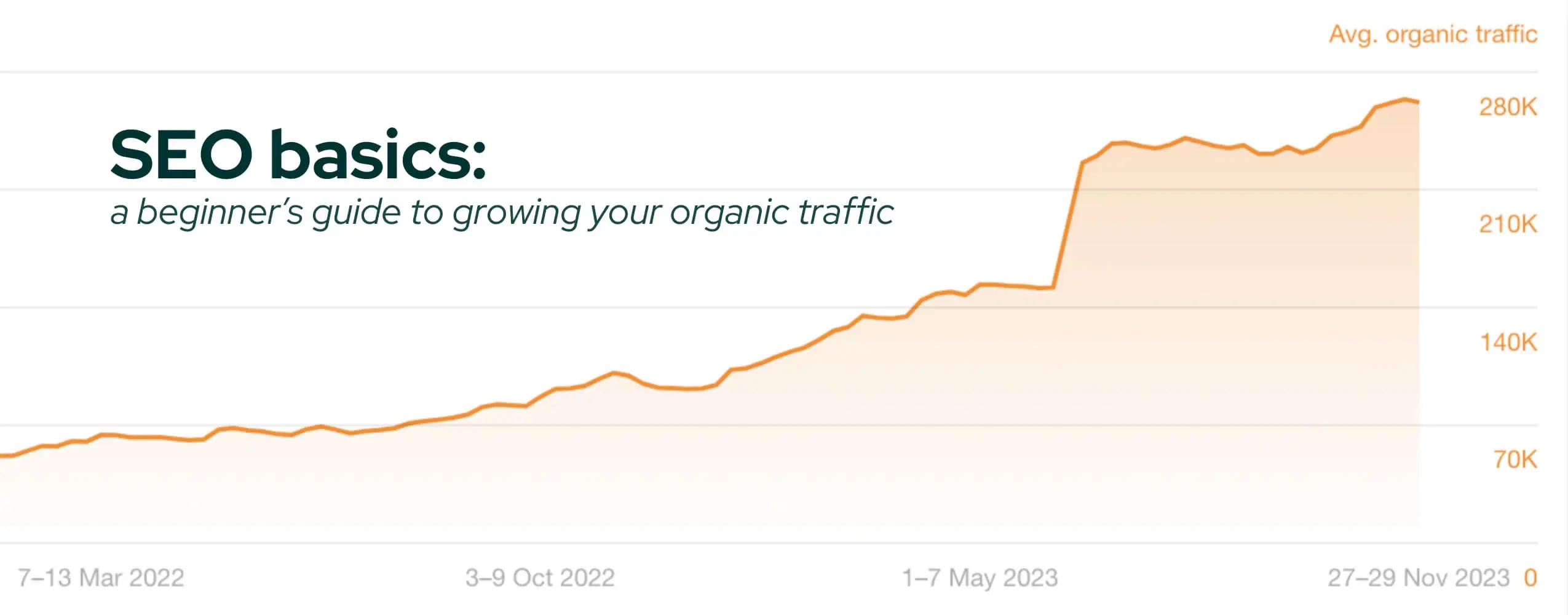
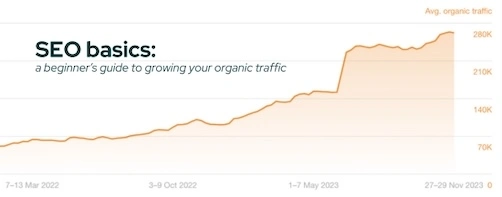
SEO basics: a beginner’s guide to growing your organic traffic
Whether you're launching a new website or looking to improve your existing one, understanding SEO basics is the first step to sustainable organic growth. SEO, or Search Engine Optimization, is how you get found online without paying for every click.
This guide covers the foundational elements of SEO. You’ll learn how to structure your site, create optimized content, and build trust signals that help your pages rank on Google. It’s built for beginners, but powerful enough to serve as the foundation for more advanced SEO strategies.
Let’s dive into the basics of SEO and start building a strategy that works.
What Is SEO?
Search Engine Optimization is the process of improving your website so that it performs better in organic search results. At its core, SEO is about helping users find what they’re looking for, and helping search engines understand your content.
Every search engine (like Google or Bing) uses bots to crawl your website and index your content. The better your site structure, content clarity, and technical setup, the easier it is for those bots to understand what your pages are about. This makes your site more likely to appear for relevant keyword searches.
SEO isn't just about bots, though. It's also about users. Good SEO ensures that your content is helpful, relevant, and aligned with what people are actually searching for online. That's where intent and content optimization come in.
Why SEO is important for organic growth
When someone types a question or product into Google, they’re often looking for a solution. If your website ranks for those queries, you’ve got a direct line to high-intent users who are ready to engage, learn, or buy.
SEO generates organic traffic, meaning you’re not paying for every click or impression. Over time, this compounds into a traffic source that drives leads, sales, and brand authority, without increasing ad spend. Focusing on SEO’s power in organic is a great way to drive down the costs of PPC and marketing campaigns. It also helps lower key metrics like CAC, or Customer Acquisition Cost.
Here’s the value of SEO in numbers:
- 53% of all website traffic comes from search
- 67% of clicks happen on page one of the search engine results page (SERPs)
- Over two-thirds of all clicks go to the first page of search results
- Local SEO drives real-world action as 28% of local mobile searches result in a purchase
If your goal is to grow traffic, improve visibility, or drive conversions, SEO should be at the center of your digital marketing strategy. Think of your website like a house where every piece plays a role in its structure and strength.
Understanding the core pillars of SEO
To succeed in search, you need a solid understanding of how SEO is structured. The five core pillars of SEO work together to support your website's performance in search engines.
Your website: the foundation of SEO
Think of your website as the blueprint of your entire SEO strategy. A well-built site that is fast, secure, and mobile-friendly is the foundation for everything else you do.
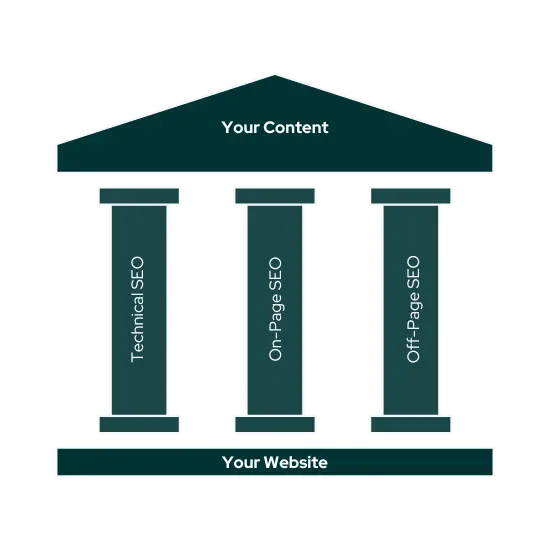
The keys to a good website:
- Mobile responsiveness so users have a smooth experience on every device
- Site speed optimization to reduce bounce rates and improve rankings
- HTTPS and security protocols to build trust with both users and Google
- Clean site architecture that helps bots crawl and index pages easily
Having a website with strong technical fundamentals is the first step toward ranking well in search results. A clean, user-friendly website creates the best foundation for all your SEO efforts.
Content: the driver of meaning and relevance
If your website is the structure, then your content is the fuel. Every blog post, product page, service description, and landing page should be written with clear intent and keyword alignment.
Good SEO content answers user questions, solves problems, and uses keyword phrases that align with search intent.
What Does SEO Content Include?
- Blog posts that answer common questions
- Service pages built around specific problems and solutions
- Product descriptions that match transactional search intent
- FAQ sections to support long-tail queries
- Supporting pages that add depth to your site (e.g., glossaries, guides, comparisons)
- Incorporating focus keywords naturally
- Structure your headings, content, and alt text with long-tail keywords
- Use an introduction, body, conclusion structure for posts
- Writing in a tone that is easy to understand and helpful
- Using bullet lists, images, headings, and paragraphs to break up content clearly
Best Practices for Content Optimization:
- Focus on intent: Know whether your page is informational, commercial, transactional, or navigational
- Use keywords naturally: Include the focus keyword once in the intro, in one subheading, and sparingly in body text
- Add internal links: Guide readers to related articles or services
- Incorporate external links: Reference trusted sources to boost credibility
- Write at a 5th-grade level: Simple, clear content ranks better and gets read more often
- Update old content: expand or update older and under performing content to be more comprehensive on your topic or fix outdated information
- Build content in a pillar/cluster, or topic cluster, format to improve internal linking
Strong SEO content helps you demonstrate expertise, experience, and authority, which plays directly into Google’s E-E-A-T (Experience, Expertise, Authority, Trust) ranking factors.

On-page SEO: optimizing individual pages
On-page SEO is all about fine-tuning the individual elements on your site’s pages. This includes your title tags, meta descriptions, image alt text, and internal linking, all of which help search engines understand what your pages are about.
When optimizing for on-page SEO:
- Use SEO-friendly title tags that include your target keyword and describe the page clearly
- Write compelling meta descriptions that encourage clicks and support your page topic
- Add descriptive alt text to images for accessibility and keyword reinforcement
- Use clean URL slugs with keywords instead of random numbers or special characters
On-page elements to optimize:
- Title Tag: Include the main keyword. Keep it under 60 characters
- Meta Description: Add a compelling summary (120–160 characters). Mention a keyword and benefit
- Headings (h1-h6): Structure your page content with headings that include keywords or questions. Make sure headings show semantic structure of the page
- Image Alt Text: Add alt tags to all images. Describe the image while reinforcing keywords
- URL Slug: Use hyphenated, keyword-based slugs (e.g., /on-page-seo-guide)
- Internal linking: Link to related articles and service pages for topic authority
- Call to Action (CTA): Tell users what to do next, “Learn More,” “Get a Quote,” etc.
- Color contrast: Check foreground and background colors with a color contrast checker or inspect element to ensure WCAG and ADA compliance levels are met. AA standard, or 4.5:1 for normal text and 3:1 for large text, is the bare minimum
On-page SEO best practices:
- Only use one h1 tag per page
- Keep your main keyword near the top of your content
- Use long-tail keywords in subheadings for extra context
- Avoid keyword stuffing. Keywords should feel natural
- Use schema markup where applicable (FAQ, How-To, Article)
Optimizing for on-page SEO factors also makes your site easier to navigate, which improves both user experience and ranking potential.
Technical SEO: enhancing crawlability and indexing
Even the best content won’t rank if search engines can’t access it. That’s where technical SEO comes in. It ensures that your website is crawlable, indexable, and free from errors that could harm your rankings.
Key areas of technical SEO:
- Site architecture: Try to follow the 3-click rule. Users should reach any important page in 3 clicks or less
- URL structure: Keep value driving categories as subfolders on the main domain to add keyword value to it from posts
- Crawlability: Ensure your robots.txt doesn’t block important pages
- Indexability: Submit and monitor your sitemap.xml in Google Search Console
- Structured data (schema): Use markup to provide extra context about your content
- Fix 404 and 500 errors: Use tools like Screaming Frog to find and eliminate broken links
- HTTPS and page security: Use an SSL to protect user data and improve trust signals
- Mobile usability: Ensure your site looks and functions properly on all devices
- Redirects: Use 301s for permanent URL changes and avoid redirect loops

Technical SEO best practices:
- Test performance with tools like Pagespeed Insights and WebPageTest
- Crawl your website using ScreamingFrog for technical errors
- Run site audits with Semrush if you have it
- Keep image sizes under 100kb if possible
- Use next-gen image formats like WebP
- Check mobile UX on real devices (not just emulator tools)
- Include schema types like Article, FAQPage, BreadcrumbList, and LocalBusiness depending on content
- Monitor your backlink profile for toxic backlinks and disavow or request removal in GSC
A technically sound website allows Google’s bots to easily understand your content and rank it accordingly. We highly suggest doing monthly crawls with ScreamingFrog to ensure your site’s technical health is strong.
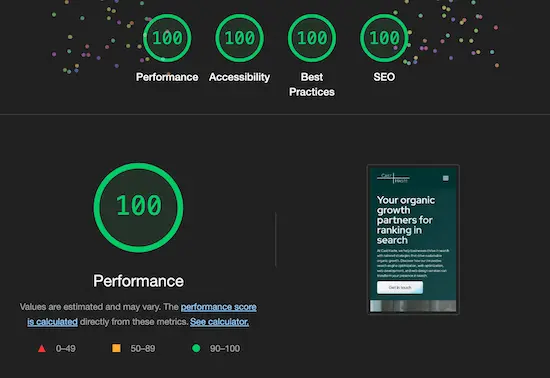
Off-page SEO: building authority and trust
Off-page SEO focuses on how other websites interact with yours. It’s all about building trust, authority, and credibility in your niche.
Off-page SEO strategies:
- Backlink building: Earn links from high-authority, relevant websites
- Guest posting: Write for other blogs in your niche with contextual links back to your site
- Brand mentions: Track unlinked mentions and reach out to request backlinks
- Local SEO: Claim and optimize your Google Business Profile and local listings
- Social engagement: Share content on platforms where your audience hangs out
- Press coverage: Get featured in relevant media outlets or industry publications
- Other marketing efforts: Billboards, signs, posters, and stickers can all increase brand awareness
Off-page SEO best practices:
- Avoid paid or spammy link schemes, and focus on relevance and trust
- Use branded anchor text and long-tail variations when linking back
- Maintain consistent NAP (Name, Address, Phone) info across all directories
- Monitor your backlink profile using Ahrefs, Moz, or Google Search Console
- Disavow or request removal of toxic links that could hurt your authority
The goal is to create a strong off-page profile that signals to Google that your website is a trusted authority in your space.
Aligning content with search intent
Search engines want to provide the most relevant content for a user’s query. To rank well, your content needs to match the search intent behind the keywords you're targeting.
There are four main types of search intent:
- Informational: The user wants to learn something (“how to optimize images for SEO”)
- Navigational: The user wants to find a specific site or tool (“Google Analytics login”)
- Commercial: The user is comparing products or services (“best SEO tools for small business”)
- Transactional: The user is ready to buy or take action (“hire SEO consultant near me”)
Matching your content’s intent to the buyer's journey helps you align with what users need at every step.
Understanding the intent of keywords in the sales funnel:
- Top of Funnel (TOFU) – Informational content like how-to guides and blogs
- Middle of Funnel (MOFU) – Commercial content like comparisons and reviews
- Bottom of Funnel (BOFU) – Transactional content like service pages, product pages, and contact forms
By identifying the intent behind each keyword, you can structure your content to meet user needs more effectively and improve conversion rates.
Building a keyword strategy that works
Your keyword strategy is the roadmap for all your content. Without one, you're just guessing.
How to build a strong keyword strategy:
- Start with a focus keyword that defines the core topic of your page
- Add long-tail keyword variations that capture more specific, lower-competition searches
- Include branded keywords to associate your company or products with relevant terms
- Use relational keywords to support semantic search and internal linking
- Map keywords to pages to ensure one page focus per focus keyword
- Understand search volumes of keywords
- Fight for keywords that are relative to your authority to grow
How to use your focus keyword in your content:
- Page title and h1
- Meta description
- Image alt text
- URL slug
- Body content (once or twice naturally)
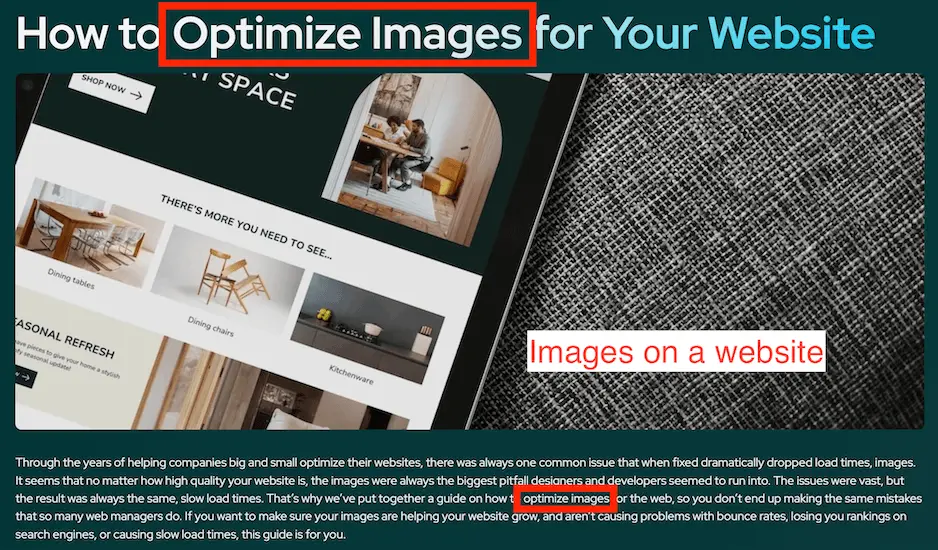
For example, a page about "on-page SEO" will use the term directly in the h1, title tag, meta description, image alt texts, URL slug, and appear in the body content once or twice. The rest of the headings and content could include long-tail and related keywords like “SEO title tags,” “internal linking strategy,” and “image optimization for SEO.”
Having a mix of keyword types helps you rank for more queries while keeping your content relevant and aligned with user intent.
Optimizing pages for readability and engagement
Once your keywords are in place, it’s time to make your content easier to read and more engaging. A great piece of content should feel effortless to consume.
Key areas of focus on for readability and engagement:
- Write at a 5th-grade reading level whenever possible
- Use short paragraphs and simple language
- Break up text with bullet points, images, and subheadings
- Include a clear call to action (CTA) at the end of every page
- Add internal links to relevant pages to keep users engaged longer
This not only improves the user experience but also boosts your session time, a signal that search engines use to measure quality and relevance.
Measuring SEO success with S.M.A.R.T. goals
To track progress, define S.M.A.R.T. goals. These are goals that are Specific, Measurable, Achievable, Relevant, and Time-bound. SEO is a long-term strategy, but setting benchmarks helps you see results over time.
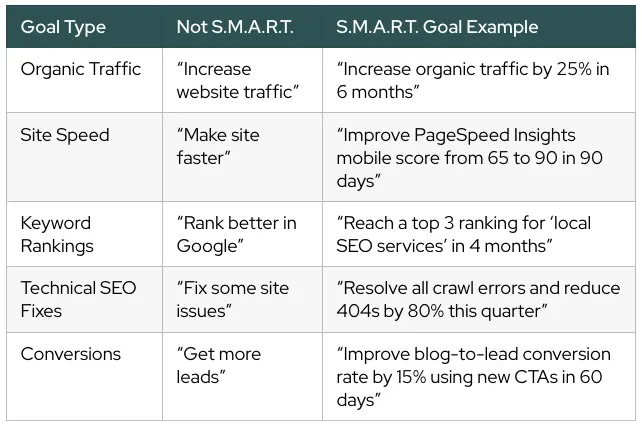
Examples of S.M.A.R.T. goals for SEO:
- Increase organic traffic by 25% over the next 6 months
- Improve PageSpeed score from 65 to 90 within 3 months
- Reduce technical errors site-wide by 80% this quarter
- Increase blog conversion rate by 15% through content optimization
Use tools like Google Analytics, Google Search Console, and Pagespeed Insights to track key performance indicators and refine your strategy based on what works. You can also get more in-depth keyword tracking capabilities with paid softwares like Ahrefs, Semrush, and SE Ranking.
A quick note here with PageSpeed Insights. Make sure you use it in an incognito window if you do it through your inspect element window because extensions can hurt your results.
Final thoughts: start simple, stay consistent
SEO doesn’t need to be overwhelming. Start with the basics: build a fast and secure site, write helpful content that targets real searches, and make sure your pages are technically sound.
As your content grows, so will your authority and organic reach. Whether you’re doing this solo or partnering with an SEO service provider like Cast Haste, remember this, the best SEO strategies are built on clarity, consistency, and value.
Need help getting started?
We specialize in SEO strategy, content optimization, and technical audits that help businesses grow with organic search. Check out Cast Haste's SEO services page to learn more.